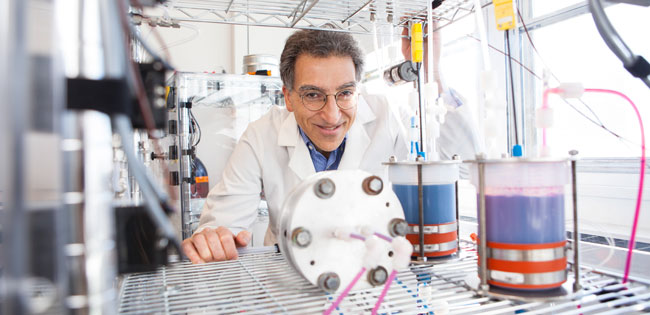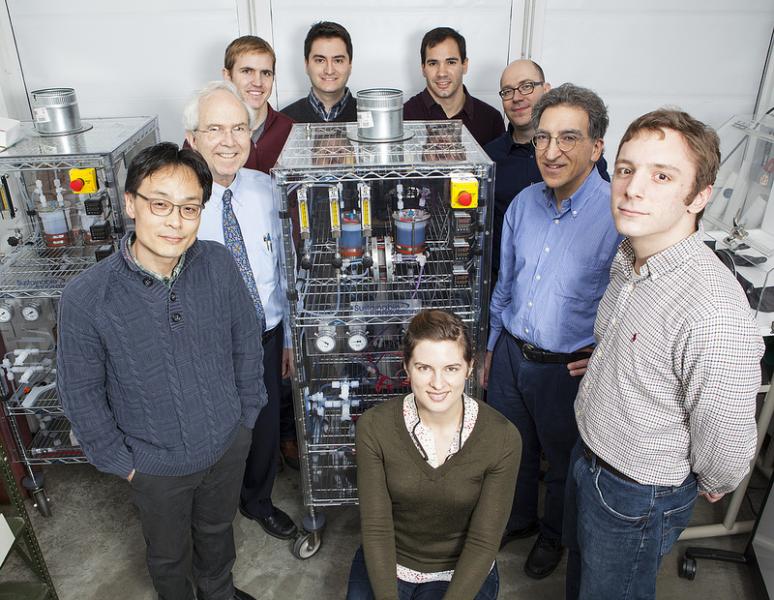 Solar already provides peak power at peak load, and through distribution
is resilient, and that plus ever-decreasing prices will drive solar
deployments up exponentially for a decade or so yet.
If we add an inexpensive metal-free battery,
solar will take over even faster.
And that’s what Harvard’s School of Engineering and Applied Sciences has just
published as a discovery.
Solar already provides peak power at peak load, and through distribution
is resilient, and that plus ever-decreasing prices will drive solar
deployments up exponentially for a decade or so yet.
If we add an inexpensive metal-free battery,
solar will take over even faster.
And that’s what Harvard’s School of Engineering and Applied Sciences has just
published as a discovery.
Harvard SEAS PR of 8 January 2014, Organic mega flow battery promises breakthrough for renewable energy: Harvard technology could economically store energy for use when the wind doesn’t blow and the sun doesn’t shine,
The paper reports a metal-free flow battery that relies on the electrochemistry of naturally abundant, inexpensive, small organic (carbon-based) molecules called quinones, which are similar to molecules that store energy in plants and animals.
And much less expensive, reported CBC News 9 January 2014, Organic battery hailed as cheap renewable energy solution: Harvard team uses material similar to molecules in rhubarb to store energy,
According to MIT Technology review, a conventional metal-reliant flow battery costs an estimated $700 per kilowatt-hour of storage capacity, whereas the Harvard team’s metal-free technology would bring those costs down to $27 per kilowatt-hour.
Since this is basic research, there’s no telling when, if ever, such batteries will be commercially available. If they ever are, they will boost the already rocketing solar deployment curve. Back to the SEAS PR:
To back up a commercial wind turbine, a large storage tank would be needed, possibly located in a below-grade basement, said co-lead author Michael Marshak, a postdoctoral fellow at SEAS and in the Department of Chemistry and Chemical Biology. Or if you had a whole field of turbines or large solar farm, you could imagine a few very large storage tanks.
The same technology could also have applications at the consumer level, Marshak said. “Imagine a device the size of a home heating oil tank sitting in your basement. It would store a day’s worth of sunshine from the solar panels on the roof of your house, potentially providing enough to power your household from late afternoon, through the night, into the next morning, without burning any fossil fuels.”
The organic chemicals used in these batteries are not only much less expensive than metals in conventional batteries, also according to the funding agency, ARPA-E:
If successful, Harvard’s organic flow battery design could hold up to 10 times more energy by volume compared to other flow batteries.
Indeed, small enough to fit in your basement.
 The paper is
A metal-free organic–inorganic aqueous flow battery
by
Brian Huskinson,
Michael P. Marshak,
Changwon Suh,
Süleyman Er,
Michael R. Gerhardt,
Cooper J. Galvin,
Xudong Chen,
Alán Aspuru-Guzik,
Roy G. Gordon,
and
Michael J. Aziz,
Nature
505,
195–198
(09 January 2014)
doi:10.1038/nature12909.
The paper is
A metal-free organic–inorganic aqueous flow battery
by
Brian Huskinson,
Michael P. Marshak,
Changwon Suh,
Süleyman Er,
Michael R. Gerhardt,
Cooper J. Galvin,
Xudong Chen,
Alán Aspuru-Guzik,
Roy G. Gordon,
and
Michael J. Aziz,
Nature
505,
195–198
(09 January 2014)
doi:10.1038/nature12909.
As the fraction of electricity generation from intermittent renewable sources—such as solar or wind—grows, the ability to store large amounts of electrical energy is of increasing importance. Solid-electrode batteries maintain discharge at peak power for far too short a time to fully regulate wind or solar power output1, 2. In contrast, flow batteries can independently scale the power (electrode area) and energy (arbitrarily large storage volume) components of the system by maintaining all of the electro-active species in fluid form3, 4, 5. Wide-scale utilization of flow batteries is, however, limited by the abundance and cost of these materials, particularly those using redox-active metals and precious-metal electrocatalysts6, 7. Here we describe a class of energy storage materials that exploits the favourable chemical and electrochemical properties of a family of molecules known as quinones. The example we demonstrate is a metal-free flow battery based on the redox chemistry of 9,10-anthraquinone-2,7-disulphonic acid (AQDS). AQDS undergoes extremely rapid and reversible two-electron two-proton reduction on a glassy carbon electrode in sulphuric acid. An aqueous flow battery with inexpensive carbon electrodes, combining the quinone/hydroquinone couple with the Br2/Br− redox couple, yields a peak galvanic power density exceeding 0.6 W cm−2 at 1.3 A cm−2. Cycling of this quinone–bromide flow battery showed >99 per cent storage capacity retention per cycle. The organic anthraquinone species can be synthesized from inexpensive commodity chemicals8. This organic approach permits tuning of important properties such as the reduction potential and solubility by adding functional groups: for example, we demonstrate that the addition of two hydroxy groups to AQDS increases the open circuit potential of the cell by 11% and we describe a pathway for further increases in cell voltage. The use of π-aromatic redox-active organic molecules instead of redox-active metals represents a new and promising direction for realizing massive electrical energy storage at greatly reduced cost.
-jsq
Short Link: